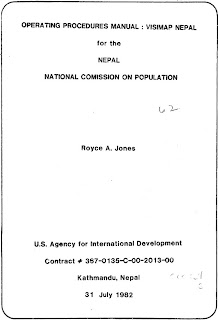But what is the earliest known example of an app to build a map from spreadsheet data? Here's my nomination.
I lived and worked in Nepal for five years. In 1979 my wife got a job teaching at Lincoln School so we moved from Mountain View, California to Kathmandu, Nepal. I had been writing software on an Apple II computer so naturally I took it with me to Nepal, little did I know that it would be one of the first computers in the entire country.
 |
| Visimap Nepal |
I was hired by USAID (United States Agency for International Development) to support government ministries' use of computers. We set them up with Apple II computers with a CP/M card running Wordstar for word processing, dBase for database management and Visicalc for spreadsheets.
I had written a few mapping programs (in Fortran) as part of my undergraduate work in geology at Stanford, so when I saw government agencies entering national datasets into spreadsheets, I thought it would be a cool idea to try and map their data. The result was Visimap Nepal, a program that would take any national data in a Visicalc spreadsheet and turn it into a map.
 |
| Population Growth Rate from Visimap Nepal |
You can easily see that the areas of high population growth were in the Terai region in the south, and the areas of low growth were in the Himalayas in the north. Similar maps were made of health data, agricultural data, forestry data, any data collected for the 75 districts in Nepal (a district in Nepal is like a state in the United States).
USAID has archived the "Operating Procedures Manual" for Visimap Nepal, here's the link:
Link to Visimap Nepal manual
So that's my nomination for the earliest app to build maps from spreadsheet data. It's been 30 years! Technology has changed a lot, but the value of seeing your data on a map is strong as ever.








